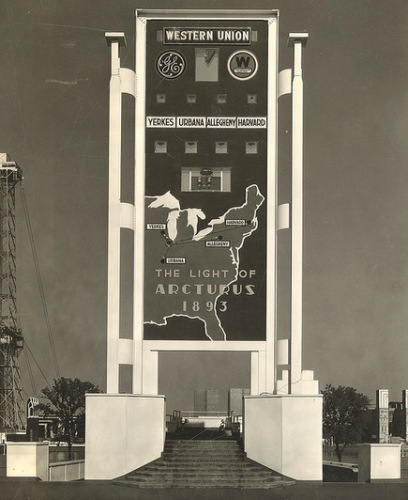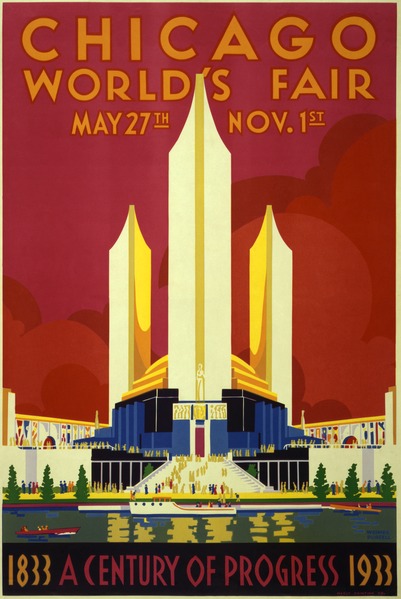 Arcturus, in the constellation Boötes the Herdsman, is the fourth-brightest star in the sky. It’s visible high overhead in late spring twilight, but you can also find it low in the west after sunset in September. All you need to do is let your eye follow the stars of the handle of the Big Dipper, which “arc to Arcturus.” (If you can’t find the Big Dipper, I can’t help you.) The star’s other claim to fame is its role in the 1933 Century of Progress Exposition in Chicago, when organizers purportedly used light from Arcturus to activate electrical lights on the Fair’s opening night.
Arcturus, in the constellation Boötes the Herdsman, is the fourth-brightest star in the sky. It’s visible high overhead in late spring twilight, but you can also find it low in the west after sunset in September. All you need to do is let your eye follow the stars of the handle of the Big Dipper, which “arc to Arcturus.” (If you can’t find the Big Dipper, I can’t help you.) The star’s other claim to fame is its role in the 1933 Century of Progress Exposition in Chicago, when organizers purportedly used light from Arcturus to activate electrical lights on the Fair’s opening night.
Or did they? There’s a maddening little mystery surrounding this event, one that has led me deep into the weeds during an ongoing book project.
The Fair was conceived by prominent business leaders in Chicago as a tribute to 100 years of technological innovation; it would use the idea of progress to buoy national optimism during the bleakest years of the Depression. Its motto was “Science Finds, Industry Applies, Man Adapts.” (Remember, this was during the days when the public celebrated science, not denounced it for telling people things they didn’t want to hear.) Exhibits were designed to demonstrate to average Americans the ways scientific research and its industrial applications not only improved everyday life but also promised a brighter future. The Fair’s centerpiece and largest building was the Hall of Science, which showcased such wonders as a bathysphere, a stratospheric gondola, a geological time clock, a gyroscopic compass, and a model of a molecule of table salt.
 In keeping with the lofty theme, Edwin B. Frost, in one of his last acts as director of Yerkes Observatory in Wisconsin, suggested to Philip Fox, the first director of the Adler Planetarium in Chicago, that the Fair be opened by an electrical signal triggered by photons from the star Arcturus. Those photons would pass through the Yerkes 40-inch refracting telescope and focus on to a photoelectric cell that would, in turn, generate the electric current needed to light up three and a half miles of lights along Chicago’s famous lakefront. Fox was a well-known and popular figure in astronomy, and his outreach efforts at the Adler also had made him a well-known figure among Chicago’s civic leaders. His enthusiasm for the idea no doubt helped gain its acceptance among those in charge of the Fair’s science exhibits.
In keeping with the lofty theme, Edwin B. Frost, in one of his last acts as director of Yerkes Observatory in Wisconsin, suggested to Philip Fox, the first director of the Adler Planetarium in Chicago, that the Fair be opened by an electrical signal triggered by photons from the star Arcturus. Those photons would pass through the Yerkes 40-inch refracting telescope and focus on to a photoelectric cell that would, in turn, generate the electric current needed to light up three and a half miles of lights along Chicago’s famous lakefront. Fox was a well-known and popular figure in astronomy, and his outreach efforts at the Adler also had made him a well-known figure among Chicago’s civic leaders. His enthusiasm for the idea no doubt helped gain its acceptance among those in charge of the Fair’s science exhibits.
The choice of Arcturus was not an arbitrary one. At the time, its distance was thought to be 40 light-years (the correct distance is actually about 36 light-years), so photons captured in 1933 could be said to have started on their journey through space in 1893, the last time a World’s Fair had been held in Chicago (and where, coincidentally, the just-constructed Yerkes 40-inch refractor — sans its giant objective lens — had been on public display). Fortunately, Arcturus is not only optimally located in the spring sky, it is also very bright. The big worry for the Fair’s opening night was whether clouds would block its view. To circumvent this possibility, three other observatories were enlisted to contribute signals from Arcturus: Harvard College Observatory, in Cambridge, Massachusetts; the Allegheny Observatory at the University of Pittsburgh; and the University of Illinois Observatory, in Urbana.
The opening ceremony just after 9 o’clock on the evening of May 27, 1933, saw over 30,000 people in attendance in the open-air court of the Hall of Science (admission, 50 cents for adults and 25 cents for children). Twice that number could hear the ceremony on loudspeakers scattered throughout the grounds, and hundreds of thousands throughout the United States (including workers at the observatories, waiting for their cue) listened to the broadcast on major radio networks. After some orotund introductory remarks about the stellar characteristics of Arcturus and photoelectric cells in general, Frost introduced Fox as the master of ceremonies. Fox spoke briefly about the importance of enriching the mind and the pioneer spirit of America, then called out to the observatories to send their impulses from Arcturus over Western Union telegraph lines to a giant 60-foot-high board of switches and relays mounted on the rostrum. In moments, the Fair’s searchlights banished the night, in Fox’s ringing words, “like the blazing purpose of mankind!” The astonished crowd, gaping at the fairyland before them, applauded wildly and roared their approval. The fact that a few photons from a distant star had been employed to bring about this spectacle was a real gee-whiz moment for young and old. The fantastic world of Tom Swift must have suddenly seemed within reach.
That is the official story, one that has been in the historical record for 80 years. Yet there is evidence, circumstantial though it may be, that a humble flashlight may have played the role of the far-removed Arcturus that evening. Tomorrow I’ll lay out the evidence for this incredible scenario.
* * *
Jeff Kanipe is the author of several popular books on astronomy, including, most recently, The Cosmic Connection: How Astronomical Events Impact Life on Earth. He is also coauthor, with his wife Alexandra Witze, of the forthcoming book Island on Fire, which chronicles the disastrous 1783 eruption of the Icelandic fissure volcano, Laki.
Images: Century of Progress Records, 1927-1952, University of Illinois at Chicago Library; WikiCommons.
I shall be waiting with bated breath – I have seen the device which supposedly did the deed, deep in the depths of the Adler’s collection, and I would be very sad to have to give credit to a flashlight instead.
Arghh! Suspense is killing me! What time are you posting part 2? I’ll set my iphone calendar to beep me when it’s time.
Posts usually go live at 4 a.m. ET, which is late enough so that our West Coast readers can still experience the previous one as part of the previous day, yet early enough that our European readers will find them in the morning mailbox.
Well, àlmost in time for the morning mail-run 😉
I’m also on the edge of my seat by the way!